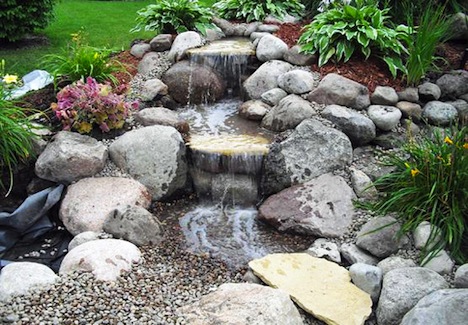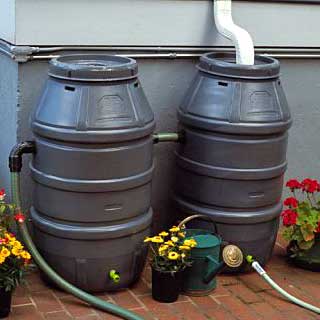Rainwater Harvesting
There's nothing quite like a nice rain shower after a long hot spell. Mother Nature can drop a large amount of water on your home and property in a very short amount of time, but periods of rain can be sporadic, unpredictable, and downright rare in some areas. Long periods of dryness can require irrigation to keep your lawn, landscaping, and gardens healthy.
Rainwater harvesting, an alternative to traditional irrigation is catching on around the country. Rainwater harvesting is a general term for the accumulation and storage of rainwater for reuse at a later time.
Rainwater Harvesting: A New Twist on an Old Idea
Humans have been collecting rainwater for drinking, irrigation, and livestock water for thousands of years. In dry, undeveloped countries with limited access to plumbing, rainwater harvesting is often the only source of water, and is relied on for simple survival. For us in the U.S., harvested rainwater is typically used as a supplemental source for outdoor irrigation, but it can also be used for flushing toilets, washing machines, and even drinking water with proper purification.
Rainwater Harvesting: As Simple or as Complex As You Want It
Rainwater harvesting is done by collecting the water as it runs off of your home, or other structures on your property. There are a wide variety of rainwater harvesting systems available; they can be as simple as a rain barrel connected to a small hose that fills with water running off your roof, to large underground tanks connected to a pressurized irrigation system. The only limits are your budget, and your imagination.Rainwater Harvesting: How Much Water?
During a rain shower, an amazing amount of water can be collected from a rooftop. How much water obviously depends on the size of the roof and how hard the rain is coming down. A house with a 1000 square foot roof in an area that receives 15.5 inches of rain a year could collect 9,600 gallons of water per year. That's a lot of water! By calculating the size of your roof area and the average amount of rain received in your area, you can roughly determine how much water your rooftop could produce per year.Rainwater Harvesting: Starting Small
The most popular way to collect rainwater, and also the most affordable, is to buy a rain collection barrel. Widely available, a rain barrel simply catches water from a gutter downspout. Usually around 55 gallons, the barrel has a spigot with a connected hose, and the collected water used to irrigate nearby gardens or landscaping.Rainwater Harvesting: Getting Bigger
For those wanting to collect more water than a simple rain barrel can provide, there are a growing number of larger above-ground rainwater containers capable of storing up to 600 or more gallons. Most systems of this type are designed to blend in with home exteriors and landscaping to be as unobtrusive as possible. These larger systems usually have pumps to move the water from the collecting tank to the yard, garden, or wherever else the water is needed.Rainwater Harvesting: Going Big
Very large, high-tech rainwater harvesting systems are available for homeowners who want to capture as much rainwater as possible. Many of these are underground cisterns capable of storing thousands of gallons of water. They utilize sophisticated plumbing and pumping to connect the collection tanks to a pressurized irrigation system for watering large areas.Rainwater Harvesting: Environmental Advantages
Collecting water from rooftops has the obvious advantage of reducing groundwater usage. Using drinking water from municipal water sources or private wells can be an expensive proposition. In many areas, groundwater is being depleted much faster than nature can replenish it. Using collected rainwater is an outstanding way to reduce, or even replace, the amount of water taken from ground or surface sources.Collecting rainwater also has the benefit of reducing the amount of water runoff from your property. Reducing runoff during storms often overwhelms sewer systems, leading to the discharge of raw sewage into rivers and streams. Collection systems allows this runoff to be used, or allows it to percolate back into the groundwater.
Rainwater Harvesting: Some Guidelines
Rainwater harvesting is closely regulated in many areas due to water rights issues and health and safety concerns. Municipalities nationwide are starting to address rainwater systems, creating regulations regarding their usage. Before investing in any larger rainwater harvesting system, check with your local government to make sure your plans are legal in your area, or if any permits are required.The water collected from your roof is often contaminated with everything from mercury washed out of the air to moss and lichens from the roof to bird feces, so it's important that it not be used for drinking unless proper filtration and purification equipment is used.
Any above-ground rainwater harvesting system should always be covered. They should have debris excluders (such as a screen mesh filter) to keep debris (and small animals) out of the tank. These above-ground tanks can be a breeding ground for mosquitos or other insects, another reason they should always be covered. And most importantly, covering these tanks will prevent children from accidental drowning.
Rainwater Harvesting and Green Home Source
Any home in any area that receives rain can benefit from a rainwater harvesting system. We at Green Home Source would be more than happy to work with you to include a rainwater system in your green home design to reduce your home's environmental impact and increase its value.
Click here to read about some excellent rainwater harvesting systems from RainXchange.
comments powered by Disqus





























































































































































































